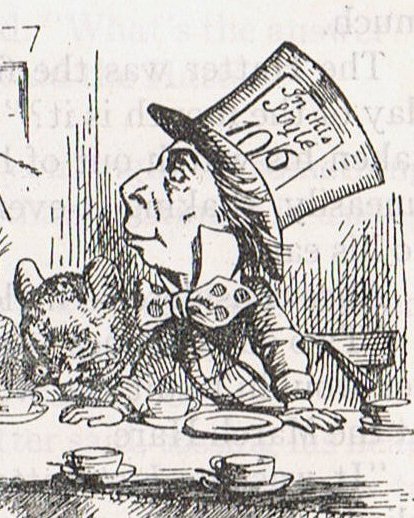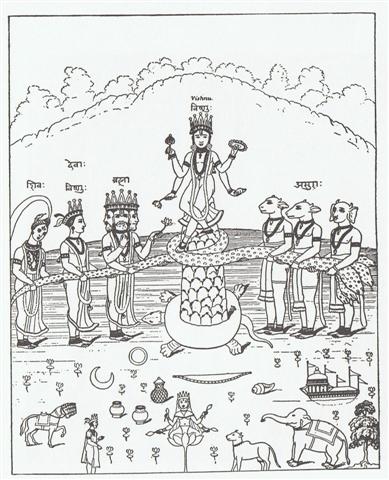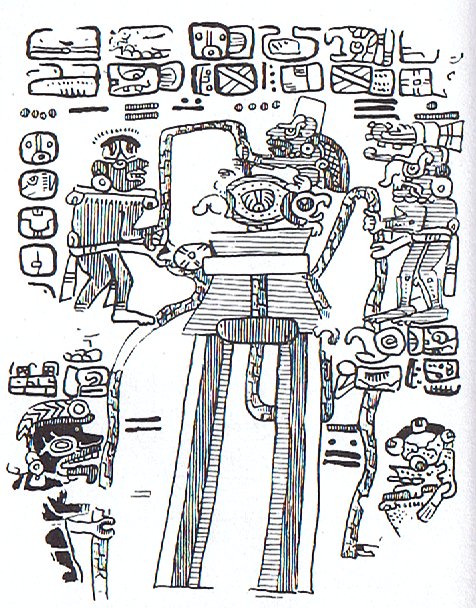Bb8.8
Presumably the creator of the B text worked with the
structure of the Rigel year, viz. with the origin (day zero)
of the year at the place where Thuban
could be observed to culminate at 21h:
 |
 |
 |
 |
 |
 |
 |
|
Bb8-26 (310) |
Bb8-27 (366 * 2) |
Bb8-28 (733) |
Bb8-29 |
Bb8-30 (314) |
Bb8-31 |
Bb8-32 |
|
kua ka ko te Raa |
i vai te taketake |
ku kotia ko te henua |
kua haaati
hia ko te kava |
kava vere ki te henua |
kua haaati
hia ko te kava
- ma te hatu huri |
eko te henua |
|
Take.
The Marquesans are the only people who
own to a distinctive national name, and
retain a tradition of the road they
travelled from their original habitat, until
they arrived at the Marquesan Islands. They
call themselves te Take, 'the
Take nation'. Fornander. Take,
Tuvaluan for the Black Noddy (Anous
Minutes). The specific epithet
taketake is Māori for long established,
ancient, or original. In the Rapa Nui
mythology, the deity Make-make was
the chief god of the birdman cult, the other
three gods associated with it being
Hawa-tuu-take-take (the Chief of the
eggs) his wife Vie Hoa and Vie
Kanatea. Wikipedia. |
|
Dec 3 |
4 |
5 |
6 |
7 (341) |
8 (364 - 22) |
9 |
|
RIGHT
ASCENSION DAYS AT THE FULL MOON: |
|
HAEDUS II = η Aurigae
(75.9) |
5h (*76.1)
ε
Leporis (76.0),
CURSA (Footstool) = β Eridani (76.4),
λ Eridani (76.7)
*35.0 = *76.4 - *41.4 |
μ Aurigae, μ Leporis (77.6) |
ĸ Leporis (78.0),
RIGEL (Foot) =
β
Orionis
(78.1),
Flaming Star = IC405
(78.2),
CAPELLA = α Aurigae (78.4),
ο
Columbae,
τ
Orionis (78.8)
*37.0 = *78.4 - *41.4
THUBAN (α Draconis) |
λ Aurigae (79.0), λ Leporis (79.6), ρ
Aurigae (79.7)
ARCTURUS (α Bootis) |
Shur-narkabti-sha-iltanu-5 (Star in the Bull
towards the north)
σ
Aurigae (80.4), BELLATRIX (Female Warrior) =
γ
Orionis, SAIF AL JABBAR (Sword of the Giant)
=
η
Orionis
(80.7),
ELNATH (The Butting One) =
β
Tauri =
γ
Aurigae
(80.9)
*39.0 = *80.4 - *41.4 |
ψ
Orionis (81.1),
NIHAL (Thirst-slaking Camels) =
β
Leporis
(81.7) |
 |
|
June 4 (155) |
5 |
6 |
7 (157
+ 1) |
8 (181
- 22) |
9
(160) |
10 / 6 |
|
'May 8
(128) |
9 |
10 |
11 (131) |
12 |
13 |
14 |
|
"April
24 (114) |
25 |
26 |
27 |
28 |
29 |
30 |
|
APRIL
1 (91) |
2 |
3 |
4 |
5 |
6 |
7 |
|
+ 366 / 2
→ |
|
OCT 1
(274) |
2 |
3 |
4 |
5 |
6 |
7 |
|
"Oct
24 (297) |
25 |
26 |
27
(300) |
28 |
29 |
30 |
June 10 (161) was the beginning of the month when
Jupiter perished,

and south of the equator the
corresponding day should be half a year later:
... Midsummer is the flowering season of the oak, which is
the tree of endurance and triumph, and like the ash is said
to 'court the lightning flash'. Its roots are believed to
extend as deep underground as its branches rise in the air -
Virgil mentions this - which makes it emblematic of a god
whose law runs both in Heaven and in the Underworld ... The
month, which takes its name from Juppiter the oak-god,
begins on June 10th and ends of July 7th. Midway comes St.
John's Day, June 24th, the day on which the oak-king was
sacrificially burned alive. The Celtic year was divided into
two halves with the second half beginning in July,
apparently after a seven-day wake, or funeral feast, in the
oak-king's honour ...

Although, as we have seen, 161 + 183 = 344 is December 10
(*264), the crux is that by adding *183 to Haedus I
(*74, June 3, 154) the sum will point at December 3 (337, *257)
instead of the expected *256 (at the Club of Hercules).
... He is a mighty hunter and makes rain, when it is needed,
by rattling an oak-club thunderously in a hollow oak and
stirring a pool with an oak branch - alternatively, by
rattling pebbles inside a sacred colocinth-gourd or, later,
by rolling black meteoric stones inside a wooden chest - and
so attracting thunderstorms by sympathetic magic ...
December 2 (336, *256) corresponds to 4 * 84 = 48 weeks. And
336 also equals = 2 * 168 = 8 * 42 = 16 * 21 = 256 + 5 * 16.
 |
 |
|
Bb8-33 |
Bb8-34 (318) |
|
ko te rima kua
hakamata ia ki te kupega |
e tagata oo - ki te
purega e |
|
Kupega. He-tá i te
kupega, to weave (a net). Hopu
kupega, those who help the motuha
o te hopu kupega in handling the
fishing nets. Huki kupega, pole
attached to the poop from which the
fishing-net is suspended. Mata kupega,
mesh. Te matu'a o te kupega,
part of a net from which the weaving
started. Te puapua kupega, the
upper part of a fishing net. Tau
kupega, rope from which is hung the
oval net used in ature fishing.
Tuku kupega, a fishing technique:
two men drag along the top of a fishing
net doubled up, spread out on the bottom
of a small cove, trapping the fish into
the net. Vanaga.
Pure.
Cowrie (Cypraea caput
draconis); pure vaka, another
type of cowrie, which can float on the
sea like a diminutive boat (vaka).
Vanaga. 1. To pray, to supplicate,
invocation, prayer; hare pure,
church, chapel; tae pure,
irreverence; purega, prayer P
Pau., Mgv., Mq., Ta.: pure, to
pray. In Samoa, Tonga, Niuē,
Futuna, Uvea, pule
means to command. 2. A shell T. P
Pau.: hakapurepure, to dye, to
color. Mq.: pué, the porcelain
shell. Ta.: pure, a mark.
Purepure, spotted, dappled; ragi
purepure, dappled sky. Purepurea,
spotted. P Pau.: hakapurepure, to
dye, to color. Mgv.: purepure,
printed cloth; akapurepure, to
paint in different colors. Mq.:
puépué, covered with pale scars.
Ta.: purepure, spotted, dappled.
Churchill.
Pureva, rock, stone (small
enough to be thrown by hand). Vanaga.
Pureva,
to throw a stone. Ta.:
Pureva,
to be on the eve of going. Ha.:
puleva,
to float here and there. Churchill.
Pau.: Pure-hiva, a butterfly.
Mgv.: pure-rehue, id. Ta.:
pure-hua, a moth. Mq.: pure-hua,
id. Ma.: pure-hua, id. Churchill. |
|
Dec 10 (*81 + 183 = *264) |
11 (345) |
|
RIGHT
ASCENSION DAYS AT THE FULL MOON: |
|
KHUFU
MINTAKA (Belt) = δ Orionis, υ Orionis (82.4),
χ Aurigae (82.5), ε Columbae (82.6)
*41.0 = *82.4 - *41.4
→ 41 Arietis (Bharani) |
KHAFRE
Al Hak'ah-3
(Brand) /
Mrigashīrsha-5 (Stag's Head)
/
Turtle Head-20
(Monkey) /
Mas-tab-ba-tur-tur (Little Twins)
ARNEB =
α
Leporis, CRAB NEBULA = M1 Tauri
(83.0,
φ¹
Orionis (83.1),
HEKA =
λ
Orionis,
ORION NEBULA = M42
(83.2),
φ²
Orionis (83.6),
ALNILAM (String of Pearls) =
ε
Orionis
(83.7) |
A string of pearls is a necklace:

I have named the glyph type at δ Orionis Rona:
... After naming the topographical features of Easter
Island with names from their land of origin, the
emissaries went from the west coast up to the rim of the
crater Rano Kau, where Kuukuu had started
a yam plantation some time earlier.
After they had departed from Pu Pakakina they
reached Vai Marama and met a man. Ira
asked, 'How many are you?'
He answered, 'There are two of us.' Ira continued
asking, 'Where is he (the other)?'
To that he answered, 'The one died.' Again Ira
asked, 'Who has died?'
He replied, 'That was Te Ohiro A Te Runu.' Ira
asked anew, 'And who are your?'
He answered, 'Nga Tavake A Te Rona.' [E:46]
After this, the emissaries and Nga Tavake went to
the yam plantation ...
|
Rona glyphs possibly depict an
effigy, a 'person' taking the place of the
king when his time has run out:
"... 'In Upper Egypt', wrote Sir James G.
Frazer in The Golden Bough, citing
the observations of a German
nineteenth-century voyager, 'on the first
day of the solar year by Coptic reckoning,
that is, on the tenth of September, when the
Nile has generally reached its highest
point, the regular government is suspended
for three days and every town chooses its
own ruler. This temporary lord wears a sort
of tall fool's cap and a long flaxen beard,
and is enveloped in a strange mantle. With a
wand of office in his hand and attended by
men disguised as scribes, executioners, and
so forth, he proceeds to the Governor's
house. The latter allows himself to be
deposed; and the mock king, mounting the
throne, holds a tribunal, to the decisions
of which even the governor and his officials
must bow. After three days the mock king is
committed to the flames, and from its ashes
the Fellah creeps forth ..." (Campbell 2)
Rona glyphs appear at the beginning of a
new season:
 |
 |
|
Gb1-13 |
Ra2-9 |
Gb1-13 probably refers to how spring has
ended and Ra2-9 to how autumn has ended. In
addition to the various
signs which can be seen in these two glyphs
there are also numbers which confirm this
interpretation:
If
we assign Gb1-13 glyph number 230 + 13 = 243
and Ra2-9 glyph number 39, then the
difference is 243 - 39 = 204 or half 408,
which in G probably indicates the length of
the solar year:
 |
 |
 |
 |
|
Gb6-25 (408) |
Gb6-26 |
Gb6-27 |
Gb6-28 |
 |
 |
 |
 |
|
Gb7-1 |
Gb7-2 |
Gb7-3 |
Gb7-4 |
|
408 - 64 = 344 (December 10) →
Bb8-33.
... 'Tell us a story!' said the
March Hare. 'Yes, please do!' pleaded Alice. 'And be
quick about it', added the Hatter, 'or you'll be
asleep again before it's done.' 'Once upon a time
there were three little sisters', the Dormouse began
in a great hurry: 'and their names were Elsie [ε,
Kaus Australis], Lacie [λ, Kaus Borealis], and
Tillie [τ, *289.4]; and they lived at the bottom of
a well — '
'What did they live on?' said
Alice, who always took a great interest in questions
of eating and drinking. 'They lived on treacle,'
said the Dormouse, after thinking a minute or two.
'They couldn't have done that, you know', Alice
gently remarked. 'They'd have been ill.' 'So they
were', said the Dormouse; 'very ill'. Alice
tried a little to fancy herself what such an
extraordinary way of living would be like, but it
puzzled her too much: so
she went on : 'But why did they live at the bottom
of a well?'
'Take some more tea [= t as in
duration of time]', the March Hare said to Alice,
very earnestly. 'I've had nothing yet', Alice
replied in an offended tone: 'so I can't take more
[<]'. 'You mean you can't take less [>]',
said the Hatter: 'it's very easy to take more than
nothing'. 'Nobody asked your opinion', said
Alice. 'Who's making personal remarks now?' the
Hatter remarked triumphantly. Alice did not quite
know what to say to this: so she helped herself to
some tea and bread-and-butter, and then turned to
the Dormouse, and repeated her question. 'Why did
they live at the bottom of a well?'
The Dormouse again took a minute or two to think
about it, and then said 'It was a treacle-well.'
'There's no such thing!' Alice was beginning very
angrily, but the Hatter and the March Hare went 'Sh!
Sh!' and the Dormouse sulkily remarked 'If you
ca'n't be civil, you'd better finish the story for
yourself.' 'No, please go on!' Alice said very
humbly. 'I wo'n't interrupt you again. I dare say
there may be one.' 'One, indeed!' said the
Dormouse indignantly. However, he consented to go
on. 'And so these three little sisters - they were
learning to draw, you know —' 'What did they draw?'
said Alice, quite forgetting her promise. 'Treacle',
said the Dormouse, without considering at all, this
time. 'I wan't a clean cup', interrupted the Hatter:
'let's all move [hop] one place on.' He moved as he
spoke, and the Dormouse followed him: the March Hare
moved into the Dormouse's place, and Alice rather
unwillingly took the place of the March Hare. The
Hatter was the only one who got any advantage from
the change; and Alice was a good deal worse off than
before, as the March Hare had just upsed the
milk-jug into his plate [creating the Milky Way
river] ...
.jpg)

|














.jpg)
